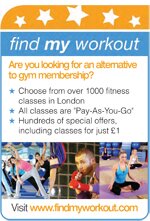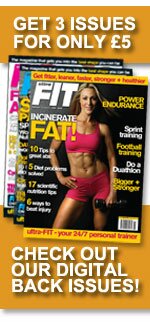Osteoporosis is a condition which causes bone mass to deteriorate drastically and often results in an increase risk of bone fracture. It’s a condition which primarily effects women but is not unheard of in men. Basically, bone breakdown (caused by cells called Osteoclasts) happens faster than the body can repair (using cells called Osteoblasts) which results in a weakening of the skeleton especially in areas where cancellous (honey comb like) bone is found – the spine, the hips and the wrists. The areas that are affected by Osteoporosis are ironically the most likely the ones that would suffer a fracture if you were to fall over. If you were to fall forwards you might break a wrist, sideways you might break a hip, or backwards you might fracture your spine. As with many chronic diseases, prevention is better than cure so in this article I’ll outline strategies for reducing the likelihood of developing this debilitating disease and will help you to develop a strong, healthy skeleton.
Osteoporosis can be caused by any number of factors including – advanced age, gender (females are more likely to develop it than males), poor nutrition, exercise habits, family history, sedentary life style, exposure to sunlight, race, (Caucasians/Asians are more likely to develop Osteoporosis than Afro/Caribbean people) chronic smoking, menstrual irregularities and premature menopause. Obviously some of these factors are beyond our control but lifestyle, diet and exercise aren’t so I’ll focus on the positive action you can take to reduce your risk of suffering Osteoporotic fractures…
1) Diet – You are what you eat. This is a vital piece of nutritional information which if more people understood there would be so much less nutrition related chronic disease. Everything we eat either becomes part of us or passes through our bodies and because of this, it is vital we consume the correct types of foods which provide all the necessary nutrients so our bodies can operate correctly. Some foods (basically sugar laden junk foods) rob the body of nutrients rather than provide them so the first dietary step we should be consider is to cut down on the amount of junk foods being consumed and increase the amount of “real” foods. Once the anti-foods have been removed, we can focus on consuming food which will enhance health and not detract from it. For bone manufacture to occur, it is essential that adequate amounts of the mineral Calcium are consumed.
Calcium is essential for lots of reasons – without it our muscles (including our hearts) wont function. Because of this, anytime the diet is low in Calcium, the body will dip into its stores (our bones) to take what it needs to keep our bodies running smoothly. About 99% of our bodies Calcium is found in our bones, and the remaining 1% is in our blood. The body will do everything it can to maintain that 1% – even if it is to the detriment of bone mass. By ensuring there is adequate Calcium in the diet, we ensure this scenario is much less likely to happen.
The recommended daily amount for Calcium consumption is 1000mg a day and
1500 mg where there is an increased risk of developing Osteoporosis or the condition has already been diagnosed. Calcium can be supplemented but it’s always better to try and consume as much natural food as possible to avoid having to pump ourselves full of pills. Foods which contain large amounts of Calcium include dairy i.e. milk, cheese, cottage cheese and yogurt, sardines and other soft boned fish, bread, baked beans and enriched breakfast cereals.
Calcium absorption is dependent on adequate amounts of vitamin D. We get most of our vitamin D from sunshine but we can also acquire it from such foods like oily fish, nuts, eggs and unprocessed plant oils. Increasing Calcium consumption with out sufficient vitamin D will reduce the amount of Calcium which can be utilized by the body. Make sure your diet is rich in both, and the risk of developing Osteoporosis should reduce significantly.
2) Exercise. Use it or lose it! Our bodies have an amazing ability to adapt to stress and exercise is a form of stress. When we exercise, we set alarm bells ringing which cause our bodies to make adaptations so that, the next time we are exposed to a similar amount or intensity of exercise, we are better equipped to deal with what is being demanded of us. In addition to our hearts, lungs and muscles, our bones also undergo positive adaptations to the stresses put through them.
When we exercise, especially weight bearing and weight lifting activities, our muscles are called upon to perform work. Our muscles are attached to our bones via connective tissue called tendons. The force our muscles produce is transmitted to our bones via these tendons which allow us to move and overcome resistance. Our bones respond to this stress by producing Osteoblasts (the bone building cells) and laying down new bone material which results in greater bone mass. If the bones are not exposed to weight lifting/bearing activities, they will become weaker and less dense – hence “use it or lose it”.
The best forms of exercise for the prevention and control of Osteoporosis are ones where a significant load is put though the skeleton. These include weight training and activities performed in the standing position e.g. running and walking (so called weight bearing activities). Exercise where bodyweight is supported externally e.g. swimming and where there is little or no skeletal loading e.g. Yoga/Pilates have a minimal effect at best on bone mass. A well rounded resistance training programme that stresses the major joints/bones of the body plus some weight bearing cardiovascular work will ensure the skeleton is being stressed appropriately which should result in increased bone mass. Exercises such as squats, dead lifts and standing presses are all excellent at putting load through the entire skeletal system resulting in positive adaptations to exercise.
NB. It should be noted however, where Osteoporosis has been diagnosed, high impact activities such as running are not recommended due to the increased risk of fracture and low impact activities combined with an appropriate resistance training programme would be more appropriate in this case.
3) Lifestyle factors. The other 164 hours a week! So, diet wise, we’re getting plenty of Calcium and vitamin D and minimizing our consumption of “nutrient robbing” highly processed food. Were hitting the gym 2-3 times a week and doing plenty of walking or jogging as appropriate. What about the rest of the week? It’s quite possible to undo all of that good by making a few not-so-great lifestyle choices.
In this last section, I’ll outline some of the things which might, despite your best efforts, negate your diet and exercise and increase the risk of lowering your bone mass.
Smoking – chronic cigarette smoking lowers Oestrogen levels in women and Oestrogen is one of the most vital hormones responsible for controlling female bone mass. Long term female smokers often suffer from a premature menopause which can hasten the onset of Osteoporosis. Testosterone levels in men are also adversely affected by smoking so the take home message is that if you treasure your bone health, then quit the cigarettes sooner rather than later.
Low bodyweight – being too thin can also have a detrimental effect on bone mass. Being very lean (>10% in females) can cause a significant drop in Oestrogen levels again resulting in lowered bone mass. It is not uncommon for very lean women e.g. competitive athletes, to suffer amenorrhea (absence of reproductive cycle) and dysmenorrhoea (irregular reproductive cycles) both of which can adversely affect Oestrogen levels. Additionally, being of low scale weight also means that a lighter person puts less stress through their skeleton during their daily activities which will, in turn, not increase in mass as readily as the skeleton of a heavier person. Increased body mass is one of the reasons men tend not to suffer Osteoporosis as often as women as they generally have a greater BMI (Body Mass Index).
Carbonated drinks – to counteract the harmful effect of carbonated drinks, the body will use Calcium as a buffer and this Calcium often comes from the bones. Carbonated drinks (including sparkling water) contain acidic ingredients which need to be neutralized to maintain even blood ph levels (ph levels refer to the degree of acidity versus alkalinity) and thus valuable Calcium is used up, leaving the bones vulnerable. If you do enjoy carbonated beverages, make sure they make up only a very small amount of your daily fluid intake and you are particularly vigilant in making sure you consume adequate dietary Calcium.
Sedentary lifestyle – as mentioned in the exercise part of this article, the body adapts to the stresses put through it. No stress = no adaptation. If our bodies are not exposed to weight bearing loads, the bones will weaken. You may have seen astronauts who have been in space for a long time returning to earth with very weak and fragile bones. This is because during their stay in space, their bodies were not being exposed to gravity and therefore very little stress. As a result they developed a form of Osteoporosis. It is vital we expose our bodies to weight bearing activities on a regular basis if we hope to maintain bone mass. Exercise IS beneficial (and vital) but additional weight bearing activities will greatly add to the overall effect. Where possible incorporate additional physical activities into your day…walk instead of ride, stand instead of sit, take the stairs rather than the elevator, and carry things that you might normally move by easier methods. Every time we apply an external load to our skeletons, our bodies will respond by making our bones stronger, or at the very least maintaining our bone mass.
Osteoporosis is a serious medical condition which, sadly for many, is only diagnosed after an Osteoporotic fracture has occurred. Prevention is better than cure so follow theses guidelines to minimize your risks.
Finally, do you know why, as we age, we tend to get shorter? Yep – Osteoporosis. The spine looses mass and collapses in on its self which will often manifest as a “Dowagers hump” (a pronounced hunch on the upper portion of the spine). I don’t know about you, but I don’t want to be a little and old. I want to be a tall, straight backed old man!!!
Note – this article is intended for entertainment only and is not intended to replace the advice of a medical professional. If you are in any doubt about Osteoporosis or need any further information, please contact your professional health advisor.
Popularity: 3% [?]

























